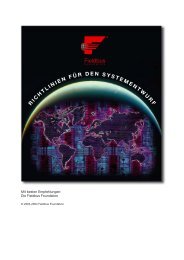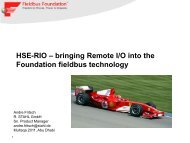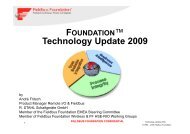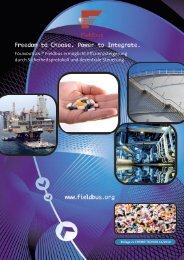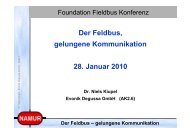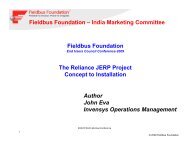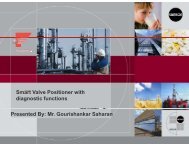HSE-RIO – bringing Remote I/O into the Foundation fieldbus ...
HSE-RIO – bringing Remote I/O into the Foundation fieldbus ...
HSE-RIO – bringing Remote I/O into the Foundation fieldbus ...
You also want an ePaper? Increase the reach of your titles
YUMPU automatically turns print PDFs into web optimized ePapers that Google loves.
1<br />
<strong>HSE</strong>-<strong>RIO</strong> <strong>–</strong> <strong>bringing</strong> <strong>Remote</strong> I/O <strong>into</strong> <strong>the</strong><br />
<strong>Foundation</strong> <strong>fieldbus</strong> technology<br />
or “<strong>the</strong> secret behind ”<br />
Dipl. Ing. Fatih Denizer<br />
Yokogawa Deutschland GmbH<br />
IMK Automation<br />
Fatih.Denizer@de.yokogawa.com
2<br />
Contents<br />
1. The technology<br />
2. The marketing
3<br />
Contents<br />
1. The technology<br />
2. The marketing
4<br />
<strong>HSE</strong> - <strong>the</strong> new kid on <strong>the</strong> block ?<br />
2003…2012
5<br />
H1 and <strong>HSE</strong> - Scalable Environment<br />
One Technology At Two Speeds<br />
H1 host<br />
FIELDBUS H1<br />
FF <strong>HSE</strong><br />
Linking Device<br />
<strong>HSE</strong>/H1<br />
FIELDBUS H1
6<br />
as of November 2011
7<br />
Wireless and <strong>Remote</strong> I/O- <strong>the</strong> new kids on <strong>the</strong> block !!!<br />
WIO = Wireless & remote IO<br />
2011
8<br />
How it started…<br />
3<br />
ISA EXPO 2006 Press Conference<br />
Latest News:<br />
Initiative Bringing <strong>Remote</strong> I/O To FOUNDATION<br />
FOUNDATION<br />
Technology (Cont’d)<br />
�� Worldwide end user demand for a single<br />
network infrastructure drives our specification<br />
development effort<br />
�� Specification will define structure for interfacing<br />
remote I/O over tightly integrated High Speed<br />
E<strong>the</strong>rnet (<strong>HSE</strong>) control backbone<br />
�� Addition of remote I/O will fur<strong>the</strong>r tighten<br />
integration of process instrumentation within <strong>the</strong><br />
FOUNDATION architecture ISA EXPO 2006 Press Conference<br />
Houston, TX<br />
FOUNDATION architecture<br />
© 1999 <strong>–</strong> 2006 Fieldbus <strong>Foundation</strong>
9<br />
…and how it is today!<br />
EUAC Advisor<br />
Herman Storey<br />
Herman Storey Consulting<br />
WIO<br />
Program Manager<br />
Jon Malins<br />
Cooper- MTL<br />
<strong>HSE</strong> <strong>RIO</strong><br />
Technical Team Leader<br />
Detlef Arndt<br />
P+F<br />
<strong>HSE</strong> <strong>RIO</strong><br />
Development Team<br />
TSC Liaison<br />
Libanio de Souza<br />
Smar<br />
WIO Program Director<br />
ISA100.15 Backhaul/Backbone Co-Chair<br />
FIC <strong>HSE</strong> Wireless Backhaul Program Manager<br />
WCT Project Coordinator<br />
TSC Chairman<br />
Dave Glanzer<br />
Fieldbus <strong>Foundation</strong><br />
WIO Chief Architect<br />
Naoyuki Fukao<br />
Yamatake<br />
ISA100.15 Backhaul/Backbone Co-Chair<br />
FIC Technical Team Leader<br />
Penny Chen<br />
Yokogawa<br />
FIC <strong>HSE</strong> Backhaul<br />
Development Team<br />
WCT Liaison<br />
WCT Technical Team Leader<br />
Marcos Peluso<br />
Emerson<br />
Wireless Sensor Interface Team<br />
Program Manager &<br />
Technical Team Leader<br />
Pat Brett<br />
Honeywell<br />
WSIT<br />
Development Team<br />
WIO Fast Track Marketing Demo<br />
Larry O’Brian<br />
Talon Petty<br />
Fieldbus <strong>Foundation</strong><br />
Device Registration<br />
Process<br />
Darie Dreptate<br />
Stephen Mitschke<br />
Fieldbus <strong>Foundation</strong><br />
WIO<br />
Validation Team Leader<br />
Johannes Lang<br />
R. STAHL<br />
WIO<br />
Validation Team
Conventio<br />
nal<br />
I/O<br />
10<br />
WIO Development Teams<br />
<strong>HSE</strong> <strong>RIO</strong> Team<br />
H1<br />
Wired<br />
HART<br />
Host<br />
Gateway<br />
Fieldbus <strong>Foundation</strong> - ISA100<br />
Cooperation<br />
WirelessHART<br />
<strong>HSE</strong> Backhaul Team<br />
ISA100.11a<br />
Wireless Sensor Team
11<br />
FOUNDATION for ROM Development Phases<br />
priority has been switched
12<br />
H1 and <strong>HSE</strong>- Scalable Environment<br />
One Technology At Two Speeds<br />
Control System<br />
Host<br />
FIELDBUS H1<br />
May be Combined<br />
Asset<br />
Managing<br />
Host<br />
FF <strong>HSE</strong><br />
WIO<br />
Conventional<br />
I/O<br />
HART AI<br />
FF <strong>HSE</strong>-<strong>RIO</strong><br />
& Wireless<br />
Wireless I/O<br />
HART<br />
AO
13<br />
More than just <strong>RIO</strong>…<br />
� 2.1 Gateways to o<strong>the</strong>r buses<br />
� 2.2 <strong>Remote</strong> Logic<br />
� 2.3 Simple I/O<br />
� 2.4 Hot Swappable I/O Cards - Transparent to Fault Tolerance<br />
� 2.5 Change field device parameter while operating<br />
� 2.6 Acyclic communication to access config, diagnostic & maintenance data<br />
� 2.7 Device Power<br />
� 2.8 Hazardous Location Installation<br />
� 2.9 Offline Configuration<br />
� 2.10 Motor Control Center Comms<br />
� 2.11 Variable Speed Drives<br />
� 2.12 Sequence of Events (High Resolution Timing)<br />
� 2.13 Redundant I/O Cards - Transparent to Fault Tolerance<br />
� 2.14 Configuration changes while in service<br />
� 2.15 Change control strategy while in service<br />
� 2.16 <strong>HSE</strong>-<strong>RIO</strong> used as an RTU<br />
� 2.17 Data buffer with Burst communications (Loss of comm without losing history)<br />
� 2.18 Process Interrupt driven control execution<br />
� 2.19 Distinguish & prioritize between Control & Device Support and Config Comms<br />
� 2.20 <strong>HSE</strong> Interoperability<br />
� 2.21 Standard Connection Mechanism (Physical Layer - Cables, Connectors etc.)<br />
� 2.22 Redundant Comm<br />
� 2.23 Fault Tolerant Comm<br />
� 2.24 Functional Safety - Support of FOUNDATION SIF<br />
� 2.25 Historic data retrieval<br />
� 2.26 Device status of self comms, physical layer & connected devices<br />
� 2.27 <strong>RIO</strong> Pass through (routable) system (i.e. VPN, Internet, Tunneling)<br />
� 2.28 Security<br />
� 2.29 Configuration change status in <strong>HSE</strong>-<strong>RIO</strong> reported<br />
� 2.30 High Frequency Update<br />
� 2.31 <strong>HSE</strong>-<strong>RIO</strong> capacities<br />
from <strong>HSE</strong>-<strong>RIO</strong> Use Case document
14<br />
Emission<br />
Monitor<br />
More potential FF <strong>HSE</strong> Applications<br />
Gas<br />
Analyzer<br />
Variable<br />
Gas Speed Drive<br />
Chromatograph<br />
Coriolis Mass<br />
Flow Meter<br />
Linking<br />
Device<br />
Ultrasonic<br />
Flow Meter<br />
Machinery<br />
Vibration<br />
Monitoring<br />
<strong>RIO</strong> &<br />
RTU<br />
Flow<br />
Computer<br />
Wireless<br />
Gateway
15<br />
So why do we need something new?<br />
To integrate a modular system for large data quantities <strong>into</strong> „classic“<br />
<strong>Foundation</strong> architecture, some add-ons were required.<br />
From „FF-061 System Architecture for WIO“:<br />
� 1. Introduction<br />
<strong>HSE</strong> <strong>Remote</strong> Input/Output devices and Wireless Gateways/RTUs are<br />
examples of high point-count <strong>HSE</strong> devices that are aggregates of<br />
various components that will vary from one user instance to ano<strong>the</strong>r<br />
user instance. The traditional small H1 device model and small<br />
pointcount <strong>HSE</strong> device model may not be a sufficient model for such<br />
a device. With device size permitted to vary from a few dozen points<br />
to several thousand points, scalability of <strong>the</strong> architecture is a<br />
requirement.
16<br />
And what‘s new now?<br />
� Association Block<br />
� special form of transducer block<br />
� also required for offline configuration<br />
� description of hirarchical and functional organization of modules (e.g.<br />
slot and functionality of installed IO-module)<br />
� association of head module (gateway) with possible set of IO-modules<br />
� association of module (I/O or gateway) with it‘s individual transducer<br />
blocks
17<br />
And what‘s new now?<br />
� Element redundancy<br />
� optional (depends on supplier)<br />
� not limited <strong>–</strong> dual, triple etc.<br />
� all kinds of redundancy supported (head module, IO-module, cable)<br />
� internal handling (e.g. configuration of modules) by head module
18<br />
And what‘s new now?<br />
� Transducer block for <strong>HSE</strong>-<strong>RIO</strong><br />
� one <strong>HSE</strong>-<strong>RIO</strong> TB for each <strong>HSE</strong>-<strong>RIO</strong> module (slot)<br />
� handles data transfer between physical IO and function block<br />
application<br />
� redundancy handled by association block<br />
� link between transducer and function block via channel tags<br />
TB TB TB
FF-AI<br />
Systembus<br />
19<br />
ABK<br />
ENG<br />
PID<br />
PNK<br />
FF-AO<br />
FF-PID<br />
Systembus<br />
ABK<br />
ENG<br />
PNK<br />
FF-AI FF-AO<br />
Systembus<br />
ABK<br />
ENG<br />
PNK<br />
FF-AI FF-AO<br />
FF-PID
20<br />
And what‘s new now?<br />
� Control in <strong>the</strong> field <strong>RIO</strong><br />
� an <strong>HSE</strong>-<strong>RIO</strong> is based on function blocks like any H1 <strong>fieldbus</strong> device<br />
� each IO-module has it‘s own function & transducer blocks<br />
� <strong>the</strong>refor a link between function blocks inside a <strong>RIO</strong> system is possible<br />
as well
21<br />
Example <strong>HSE</strong>-<strong>RIO</strong> configuration
22<br />
Example <strong>HSE</strong>-<strong>RIO</strong> configuration
23<br />
E<strong>the</strong>rnet & <strong>HSE</strong> <strong>–</strong> <strong>the</strong> perfect team<br />
Additional diagnostics via Webserver
24<br />
Contents<br />
1. The technology<br />
2. The marketing
25<br />
History<br />
� October 2006: FF announces a new development project<br />
„integration of <strong>Remote</strong> I/O <strong>into</strong> <strong>Foundation</strong> technology via FF<br />
<strong>HSE</strong>“<br />
� End 2006: ano<strong>the</strong>r new working group „FF wireless“<br />
� January 2007: FF <strong>HSE</strong>-<strong>RIO</strong> working group founding<br />
meeting“ (at R. STAHL Waldenburg)<br />
� 2008: „FF <strong>HSE</strong>-<strong>RIO</strong>“ & „FF wireless“ combined to WIOproject<br />
(Wireless & remote I/O)<br />
� End 2010: validation working group started (with R. STAHL<br />
as team leader)<br />
� middle 2011: new technology name to focus on<br />
applications: <strong>Foundation</strong> for <strong>Remote</strong> Operations<br />
Management -
26<br />
Does it work?<br />
Media Event <strong>–</strong> 1 st of Dec. 2011
27<br />
Introducing FOUNDATION for <strong>Remote</strong> Operations<br />
Management<br />
• Provides a wireless and wired infrastructure for remote assets and applications, all<br />
within FOUNDATION <strong>fieldbus</strong><br />
• Integrates Wired Infrastructure, <strong>Remote</strong> I/O, ISA100.11a and WirelessHART®<br />
• Incorporate remote operations data <strong>into</strong> FOUNDATION Fieldbus infrastructure for data<br />
management with direct access to device diagnostics<br />
• FOUNDATION for ROM has <strong>the</strong> potential to transform remote operations, providing<br />
greater reliability and reduced costs.
28<br />
Application Examples: Tank Farms<br />
• Overfill Protection, Integration of Fire & Gas<br />
Detection
29<br />
Application Examples: Pharma<br />
• Faster Integration of Multiple<br />
Skid Mounted Mobile Units<br />
• Faster Commissioning<br />
• Easier Validation<br />
• Reduced Cost to Both End<br />
User and OEM<br />
FOUNDATION Fieldbus<br />
Instrumentation on a Skid<br />
Mounted Fermenter<br />
Source: PharmaManufacturing.com
30<br />
The next steps…<br />
� <strong>Foundation</strong> has started F-ROM:<br />
<strong>Foundation</strong> for <strong>Remote</strong> Operations<br />
Management<br />
� Various end user demos in 2012 until 2013<br />
� End users to specify F-ROM for future<br />
projects<br />
� DCS suppliers to support this new F-ROM<br />
functionality



